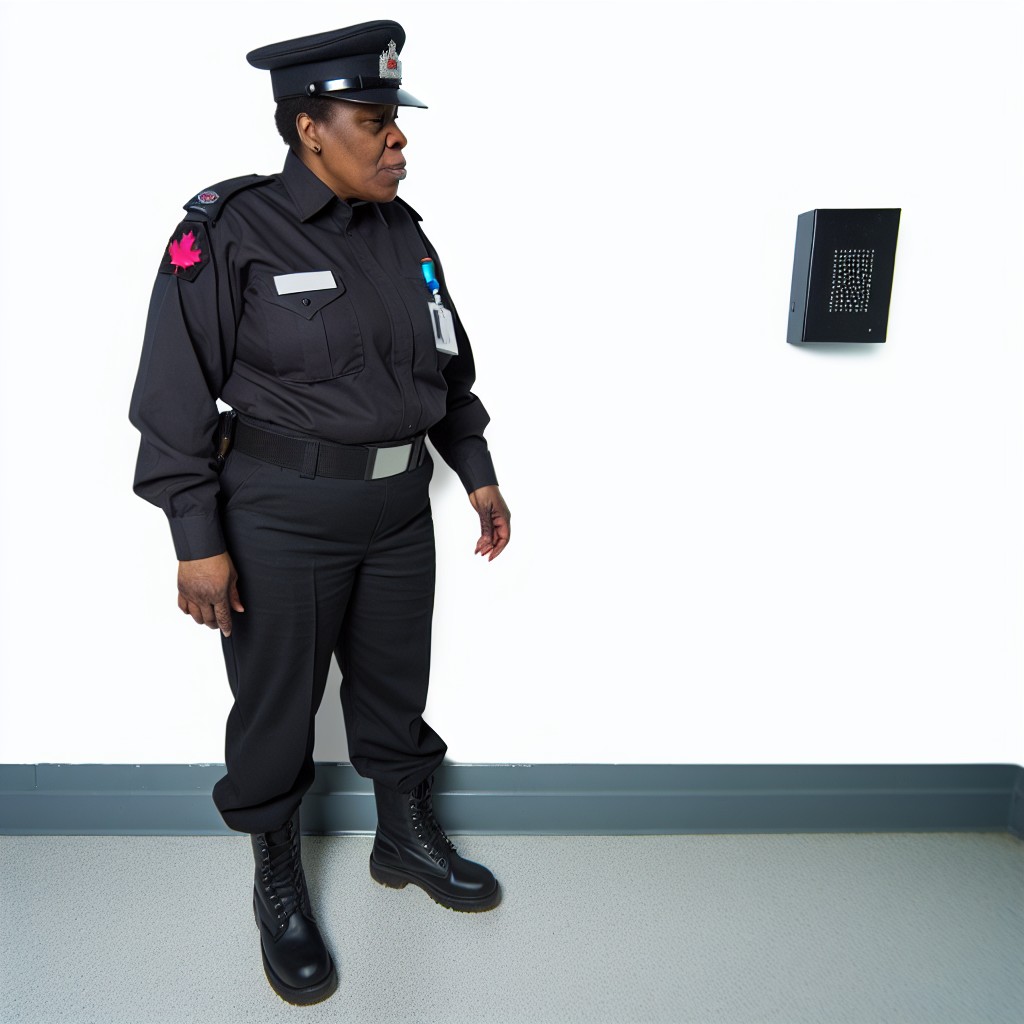Understanding the Role of Communication in Correctional Settings
Importance of Effective Communication
Effective communication is crucial in correctional facilities.
It helps maintain order and ensures safety for both staff and inmates.
Clear communication prevents misunderstandings that could escalate conflicts.
Furthermore, it fosters positive relationships among colleagues and inmates.
Building Rapport with Inmates
Building rapport is essential for effective interactions.
Correctional officers must learn to listen actively and empathize.
This approach encourages inmates to express themselves openly.
As a result, trust develops, which enhances communication.
Nonverbal Communication Skills
Nonverbal cues play a significant role in communication.
Body language, eye contact, and facial expressions convey messages.
Correctional officers should be aware of their own nonverbal signals.
A positive demeanor can help de-escalate tense situations.
Communication During Emergencies
Communication is vital during emergencies or crises.
Officers must provide clear instructions to maintain safety.
Calm and concise communication can prevent panic among inmates.
Additionally, a coordinated response is necessary for effective crisis management.
Enhancing Team Communication
Effective teamwork relies on strong communication skills.
Correctional officers must share information and provide updates regularly.
Regular meetings can improve coordination and cohesion among staff.
Moreover, open channels for feedback foster a supportive work environment.
Types of Communication Skills Essential for Correctional Officers
Verbal Communication
Verbal communication is crucial in correctional settings.
Officers must convey clear instructions to inmates.
They should also articulate strategies effectively.
In high-stress situations, tone matters significantly.
Using a calm and authoritative tone promotes respect.
Unlock Your Career Potential
Visualize a clear path to success with our tailored Career Consulting service. Personalized insights in just 1-3 days.
Get StartedActive Listening
Active listening enables officers to understand inmates better.
It involves focusing fully on the speaker.
This skill enhances rapport between officers and inmates.
Moreover, it helps identify potential issues early.
Practicing active listening reduces misunderstandings.
Non-Verbal Communication
Non-verbal cues play a vital role in corrections.
Body language can convey authority and confidence.
Eye contact fosters trust and openness.
Additionally, facial expressions can indicate empathy.
Being aware of these cues aids communication effectiveness.
Conflict Resolution
Conflict resolution skills are essential for safety.
Correctional officers often handle volatile situations.
They must de-escalate conflicts calmly and professionally.
Using negotiation techniques can lead to peaceful outcomes.
Understanding various conflict styles helps in resolution.
Empathy and Compassion
Empathy is crucial in managing inmate interactions.
Correctional officers should understand inmates’ perspectives.
This approach fosters a more cooperative environment.
Compassionate communication can reduce hostility.
Furthermore, it promotes rehabilitation efforts.
Cultural Competency
Cultural competency enhances communication in diverse settings.
Officers should be aware of cultural differences.
This awareness fosters respect and reduces tension.
Training in cultural nuances improves interactions.
Moreover, it helps in managing a diverse inmate population.
Verbal Communication: Techniques and Strategies for Effective Interaction
Importance of Clear Communication
Clear communication is vital for correctional officers in Canada.
It helps manage relationships with inmates effectively.
Moreover, clarity reduces misunderstandings during interactions.
Active Listening Techniques
Active listening enhances the officer’s understanding of inmate concerns.
Officers should maintain eye contact while attentively listening.
Additionally, repeating key points helps confirm comprehension.
Using Nonverbal Cues
Nonverbal communication plays a significant role in interaction.
Facial expressions can convey empathy or authority.
Body language should remain open and non-threatening.
Building Rapport
Establishing rapport is essential for maintaining order.
Officers can build rapport by showing respect to all inmates.
Furthermore, using a calm voice can promote a peaceful environment.
De-escalation Strategies
Effective communication helps de-escalate tense situations.
Officers should use a low, even tone to calm aggressive behaviors.
Using open-ended questions can encourage dialogue and cooperation.
Providing Clear Instructions
Correctional officers must give clear and concise directives.
This minimizes confusion and promotes compliance among inmates.
Additionally, officers should confirm that instructions are understood.
Adapting Communication Styles
Different inmates may require varied communication approaches.
Officers should adapt their tone and style based on individual needs.
For example, some may respond better to a more assertive approach.
Utilizing Feedback
Feedback is critical for improving communication skills.
Correctional officers should seek input from peers and supervisors.
This can highlight areas for growth and enhanced effectiveness.
Learn More: Impact of Border Services Officers on Canadian Economy
Non-verbal Communication: Reading Body Language and Facial Expressions
Importance of Non-verbal Communication
Non-verbal communication plays a vital role in corrections.
Officers must effectively interpret body language.
Doing so enhances safety and security in facilities.
It also fosters better relationships with inmates.
Understanding Body Language
Body language includes gestures, posture, and movement.
These non-verbal cues convey emotions and intentions.
Correctional officers should observe these cues carefully.
Common Gestures and Their Meanings
Crossed arms often indicate defensiveness or resistance.
A raised hand may signal a desire to speak or interrupt.
Fidgeting can point to anxiety or discomfort.
Posture and Space
Open posture reflects confidence and approachability.
Conversely, a closed posture can suggest withdrawal.
Officers must also recognize personal space boundaries.
This awareness helps reduce tension in interactions.
Interpreting Facial Expressions
Facial expressions reveal a wealth of information.
They can indicate happiness, anger, or sadness.
Training officers to read these cues is essential.
Key Facial Expressions to Recognize
A smile can indicate friendliness or approval.
A furrowed brow often signals confusion or concern.
Quick eye movements may suggest nervousness or suspicion.
Practical Tips for Correctional Officers
Officers should practice active observation skills.
Regular training sessions on non-verbal cues are beneficial.
Role-playing different scenarios can enhance skills.
Developing Observation Skills
Officers can improve by focusing on individuals’ non-verbal signals.
Compare their expressions to the context of the conversation.
Recording and reviewing interactions can aid learning.
Responding to Non-verbal Signals
Understanding body language allows officers to respond appropriately.
If an inmate seems defensive, a calming approach may help.
Adapting to these cues can de-escalate situations.
Gain More Insights: Canadian Provinces with High Demand for Environmental Officers
Conflict Resolution: Communication Strategies to De-escalate Situations
The Importance of Effective Communication
Effective communication plays a crucial role in conflict resolution.
It helps correctional officers understand inmates’ perspectives.
Additionally, it fosters trust and respect between staff and inmates.
Understanding Body Language
Body language can significantly impact communication outcomes.
Officers should maintain an open posture to convey approachability.
Avoiding crossed arms can reduce perceived defensiveness.
Furthermore, maintaining eye contact demonstrates attentiveness and respect.
Verbal De-escalation Techniques
Using calming language can help diffuse tense situations.
For instance, adopting a soft tone and clear speech is essential.
Officers should also use empathetic statements to acknowledge feelings.
Furthermore, asking open-ended questions encourages dialogue.
Active Listening Skills
Active listening is critical in conflict resolution.
Correctional officers must give full attention to the speaker.
Reflecting back what the speaker says shows comprehension and respect.
Additionally, summarizing the main points can clarify any misunderstandings.
Collaborative Problem Solving
Encouraging collaboration can lead to effective conflict resolution.
Officers should invite inmates to participate in finding solutions.
Moreover, setting common goals can unify conflicting parties.
This approach fosters a sense of ownership over the resolution process.
Maintaining Professional Boundaries
Professional boundaries are vital in correctional settings.
Officers should remain objective and avoid personal involvement.
Setting clear limits helps maintain authority and respect.
Ultimately, professionalism ensures a safe and constructive environment.
You Might Also Like: Roles and Responsibilities of an Environmental Officer

Building Rapport with Inmates
The Significance of Empathy in Communication
Effective communication relies heavily on empathy.
Correctional officers must develop emotional connections with inmates.
Understanding an inmate’s perspective fosters a respectful environment.
This approach can lead to enhanced cooperation from inmates.
Empathy helps reduce conflicts within correctional facilities.
Inmates often feel misunderstood and isolated.
By expressing empathy, officers promote a sense of belonging.
This engagement can improve overall inmate behavior.
Building Trust through Active Listening
Active listening is essential for effective communication.
Correctional officers should focus on understanding inmate concerns.
By repeating back what inmates say, officers confirm their understanding.
This technique demonstrates genuine interest in their feelings.
It also encourages inmates to express themselves openly.
When inmates feel heard, they are more likely to cooperate.
Active listening establishes a foundation of trust.
Utilizing Non-Verbal Communication
Non-verbal cues play a significant role in communication.
Body language can convey empathy more than words alone.
Correctional officers should maintain open postures and eye contact.
This approach signals approachability and reassurance.
Moreover, facial expressions can reflect understanding and concern.
Being mindful of these non-verbal signals is crucial.
Responding to Inmate Emotions
Officers must be adept at recognizing inmate emotions.
Validating feelings is a key component of effective communication.
Instead of dismissing emotions, officers should acknowledge them.
This recognition can de-escalate potentially volatile situations.
Moreover, it fosters an environment of respect and understanding.
Encouraging Open Dialogue
Creating an environment for open dialogue is beneficial.
Correctional officers should invite inmates to share their thoughts.
Encouraging discussions can lead to better problem-solving.
Regular dialogue can also help address grievances promptly.
This approach reduces the likelihood of conflicts and tensions.
Furthermore, it allows officers to gain insight into inmate needs.
Find Out More: Differences Between Federal and Provincial Correctional Roles
Cultural Sensitivity and Its Role in Effective Communication with Diverse Populations
Understanding Cultural Sensitivity
Cultural sensitivity refers to being aware of and respecting different cultural backgrounds.
It emphasizes the importance of acknowledging diverse perspectives.
This awareness enhances communication practices among correctional officers.
Building Rapport with Individuals from Various Cultures
Establishing rapport is vital in correctional settings.
Officers must approach interactions with openness and a willingness to learn.
Active listening plays a key role in understanding individuals’ needs.
Furthermore, using appropriate body language can foster trust.
Enhancing Communication Skills through Training
Training programs on cultural sensitivity are essential for correctional officers.
These programs should include practical scenarios and role-playing exercises.
Moreover, continuous education promotes awareness of changing demographics.
This ongoing learning enables officers to adapt their communication styles effectively.
Overcoming Language Barriers
Language barriers can hinder effective communication in correctional facilities.
Utilizing interpreters or translation services can facilitate understanding.
Offering written materials in multiple languages is also beneficial.
Additionally, encouraging the use of visual aids can bridge gaps in communication.
Respecting Diverse Beliefs and Practices
Correctional officers encounter individuals from various faiths and belief systems.
Recognizing and respecting these beliefs fosters a positive environment.
Officers should remain open to discussing religious or cultural practices.
Demonstrating respect can significantly reduce tensions and misunderstandings.
Implementing Feedback Mechanisms
Feedback mechanisms allow officers to learn from their interactions.
Conducting surveys and interviews with inmates can provide valuable insights.
This information helps improve communication strategies and practices.
Furthermore, creating an open dialogue encourages continuous improvement.
Developing Empathy and Understanding
Empathy is crucial for effective communication in correctional settings.
Officers need to put themselves in others’ shoes to understand their perspectives.
Emphasizing shared humanity can significantly enhance interpersonal relationships.
Encouraging emotional intelligence training can also aid in developing this skill.
Training and Development Programs for Enhancing Communication Skills among Correctional Officers
Importance of Communication Skills
Communication skills are essential for correctional officers in Canada.
They enhance safety and order within facilities.
Effective communication fosters positive relationships with inmates.
Moreover, it aids in conflict resolution and crisis management.
Types of Training Programs
Various training programs exist to improve these skills.
Workshops focus on verbal and non-verbal communication techniques.
Critical incident de-escalation training emphasizes handling tense situations.
- Role-playing exercises enhance practical communication skills.
- Group discussions encourage collaborative problem-solving.
- Simulations provide real-world scenarios for experiential learning.
Integrating Technology in Training
Using technology can significantly enhance training outcomes.
Online courses offer flexibility and accessibility for correctional staff.
Video analysis tools help in assessing communication styles.
Furthermore, interactive platforms promote engagement and learning.
Evaluating Training Effectiveness
Measuring the effectiveness of training programs is crucial.
Feedback surveys from participants can highlight strengths and weaknesses.
Additionally, ongoing assessments help track skill development over time.
- Regular refresher courses maintain skill proficiency.
- Peer evaluations provide insights into communication practices.
- Observation by supervisors can identify areas for improvement.
Case Studies and Success Stories
Successful communication training programs offer valuable insights.
The Ontario Ministry of Correctional Services implemented an extensive training module.
This program led to improved inmate interactions and reduced incidents.
Similarly, the British Columbia Corrections adopted a conflict resolution program.
They reported a noticeable decline in violent confrontations.
Future Directions for Training
As challenges evolve, training must adapt to new realities.
Incorporating mental health awareness into communication training proves essential.
Furthermore, cultural sensitivity training will enhance interactions with diverse populations.
Ultimately, continuous improvement will foster a professional environment.
Additional Resources
Approaches to Addressing Serious Mental Illness in the Canadian …




